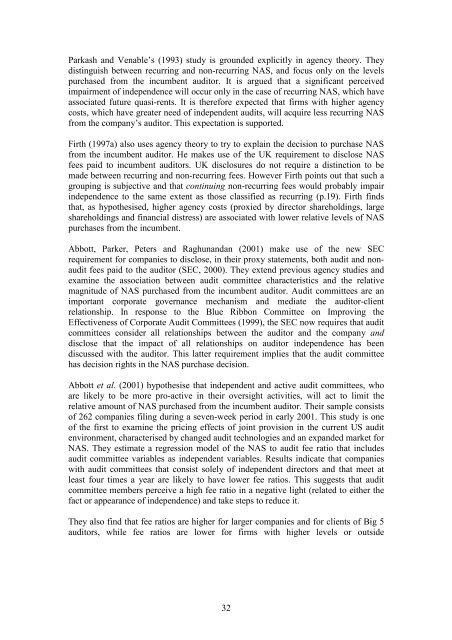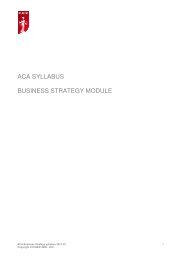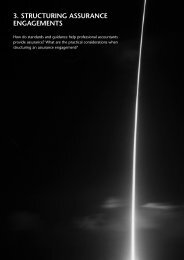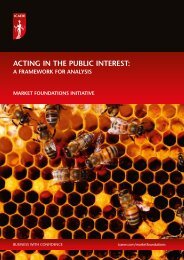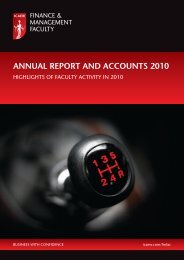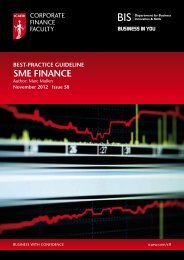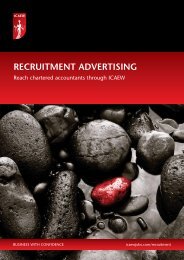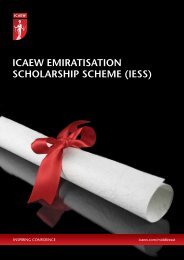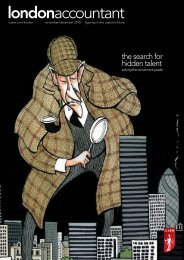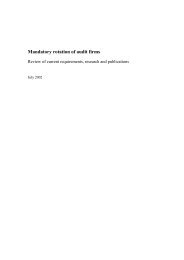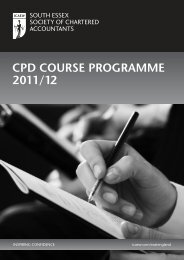Auditor independence and non-audit services - ICAEW
Auditor independence and non-audit services - ICAEW
Auditor independence and non-audit services - ICAEW
You also want an ePaper? Increase the reach of your titles
YUMPU automatically turns print PDFs into web optimized ePapers that Google loves.
Parkash <strong>and</strong> Venable’s (1993) study is grounded explicitly in agency theory. Theydistinguish between recurring <strong>and</strong> <strong>non</strong>-recurring NAS, <strong>and</strong> focus only on the levelspurchased from the incumbent <strong>audit</strong>or. It is argued that a significant perceivedimpairment of <strong>independence</strong> will occur only in the case of recurring NAS, which haveassociated future quasi-rents. It is therefore expected that firms with higher agencycosts, which have greater need of independent <strong>audit</strong>s, will acquire less recurring NASfrom the company’s <strong>audit</strong>or. This expectation is supported.Firth (1997a) also uses agency theory to try to explain the decision to purchase NASfrom the incumbent <strong>audit</strong>or. He makes use of the UK requirement to disclose NASfees paid to incumbent <strong>audit</strong>ors. UK disclosures do not require a distinction to bemade between recurring <strong>and</strong> <strong>non</strong>-recurring fees. However Firth points out that such agrouping is subjective <strong>and</strong> that continuing <strong>non</strong>-recurring fees would probably impair<strong>independence</strong> to the same extent as those classified as recurring (p.19). Firth findsthat, as hypothesised, higher agency costs (proxied by director shareholdings, largeshareholdings <strong>and</strong> financial distress) are associated with lower relative levels of NASpurchases from the incumbent.Abbott, Parker, Peters <strong>and</strong> Raghun<strong>and</strong>an (2001) make use of the new SECrequirement for companies to disclose, in their proxy statements, both <strong>audit</strong> <strong>and</strong> <strong>non</strong><strong>audit</strong>fees paid to the <strong>audit</strong>or (SEC, 2000). They extend previous agency studies <strong>and</strong>examine the association between <strong>audit</strong> committee characteristics <strong>and</strong> the relativemagnitude of NAS purchased from the incumbent <strong>audit</strong>or. Audit committees are animportant corporate governance mechanism <strong>and</strong> mediate the <strong>audit</strong>or-clientrelationship. In response to the Blue Ribbon Committee on Improving theEffectiveness of Corporate Audit Committees (1999), the SEC now requires that <strong>audit</strong>committees consider all relationships between the <strong>audit</strong>or <strong>and</strong> the company <strong>and</strong>disclose that the impact of all relationships on <strong>audit</strong>or <strong>independence</strong> has beendiscussed with the <strong>audit</strong>or. This latter requirement implies that the <strong>audit</strong> committeehas decision rights in the NAS purchase decision.Abbott et al. (2001) hypothesise that independent <strong>and</strong> active <strong>audit</strong> committees, whoare likely to be more pro-active in their oversight activities, will act to limit therelative amount of NAS purchased from the incumbent <strong>audit</strong>or. Their sample consistsof 262 companies filing during a seven-week period in early 2001. This study is oneof the first to examine the pricing effects of joint provision in the current US <strong>audit</strong>environment, characterised by changed <strong>audit</strong> technologies <strong>and</strong> an exp<strong>and</strong>ed market forNAS. They estimate a regression model of the NAS to <strong>audit</strong> fee ratio that includes<strong>audit</strong> committee variables as independent variables. Results indicate that companieswith <strong>audit</strong> committees that consist solely of independent directors <strong>and</strong> that meet atleast four times a year are likely to have lower fee ratios. This suggests that <strong>audit</strong>committee members perceive a high fee ratio in a negative light (related to either thefact or appearance of <strong>independence</strong>) <strong>and</strong> take steps to reduce it.They also find that fee ratios are higher for larger companies <strong>and</strong> for clients of Big 5<strong>audit</strong>ors, while fee ratios are lower for firms with higher levels or outside32


